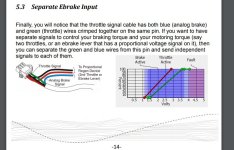BlueSeas said:
I had to smile at the thought of having cruise control active while charging!
Not a likely circumstance...but possible, if for instance you have solar panels on the bike/trike/etc., and their output happens to be more than the motor is taking.
Surprised that they are out of room already since the V3 CA isn't that old.
It's actually several years old, and they're already at v3.1.12 or .13 or something, so many minor revisions.
Last I recall, in either the Solar CA thread or the CA 3 beta thread, Justin said something about having had to take some other feature out to add the most recent new one. Sometime in the last several months, IIRC, but don't remember what it was about.
He's also said that there's a new hardware version in the works, to help with that, and some other stuff, but I don't recall him saying anything about exactly what that would be.
There are a number of things I would personally like to see fixed and added to the CA'; off the top of my head a here's a short list that doesn't involve hardware changes:
--separate PAS and throttle throttle settings, so neither affects the other and are completely independent.
--more than three presets (say, at least 10).
--PAS scaling values that allow using large amounts of power from a stop when applying full (or at least high, referenced to whatever the presetn settings are) torque to the cranks, for heavy cargo bikes/trikes and the like.
--PAS scaling curve creation on the PC setup utility to allow a user to tailor power application to their needs vs the bike/trike's ability to keep placing torque on the cranks, etc., and to allow fading out of torque control into cadence control. This is especially useful for trikes like mine that are geared VERY low for the cranks, so that I could pedal it home without power if necessary, at a couple MPH or less, but that don't have a gear high enough to allow torque to be placed on the cranks at all above a few MPH, yet the rider wants to continue to apply motor power above that speed using PAS only.
--PAS ability to start with torque-only, with a settable "start limit" so you can't accidentally engage power but have to apply some higher level of torque to the cranks (but doesn't require rotation of cranks to engage). (This would not only allow the use of PAS-only control of a heavy cargo bike/trike, but also using torque-based (or other control method) sensors of non-rotational input devices, without having to use the throttle input for them instead with some external conversion electronics).
And a few that do involve hardware:
--twin throttle outputs on independent wires, each with their own settings just like the single throttle does now (for dual motor setups).
--twin throttle inputs on independent wires, , each with their own settings just like the single throttle does now (for dual motor setups).
--modes to use the above such that they can be "merged throttles" (either throttle controls both outputs, higher throttle percentage "wins" if both are in use) or "independent throttles" (each controls it's own output).
--analog ebrake input and (optional) output, each on it's own wire
--PAS ability to reverse the motion of a trike/etc, by rotating cranks backwards. This would have the CA engage a new output (with 1/0 settable output mode) to engage the reverse mode of whatever controller was in use, and then output the throttle requested by the cranks. Since the cranks in reverse on a bike/trike generally just spin this would use cadence-sensor-mode only, as there wouldn't be torque control over it when using a typical (non-coaster-brake) bicycle-type drivetrain.
--isolated power input to the CA, from it's internal electronics and output wiring. This *might* help prevent CA destruction from phase/hall shorts and the like, if the grounds weren't the same.
--overvoltage protection on all inputs and outputs, to prevent damage to the CA during various wiring and component faults (especially stuff like the two common ones: axle wires mangled in crash/etc, shorting battery voltage stuff and low votlage stuff together, and throttle signals and/or 5v power being shorted to battery voltage when rain/etc gets into a throttle that has a battery-level meter built in.
--overcurrent protection on the outputs, especially on the 5v and 10v power lines, so you can't destroy your CA just by hooking up a PAS sensor when your battery is more than whatever the limit is (60v? I forget). Or a better LVPS that cant' be destroyed like that. Or both.

I expect that Grin will say there's simply not enough demand or value for any of these features to be implemented, so I haven't submitted them. (but thought I'd type them in here as a reference anyway).


